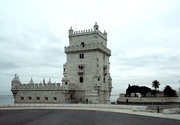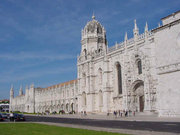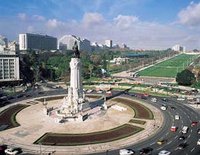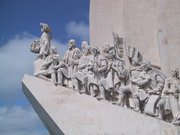Lisbon
|
|
- For other uses, see Lisbon (disambiguation).Template:Infobox Municipality pt
Lisbon (in Portuguese, Lisboa) is the capital and largest city of Portugal. It is the seat of the district of Lisbon.
| Contents [hide] |
Geography and Location
Lisbon is situated at 38°43' north, 9°8' west (38.71667, 9.1333), making it the westernmost capital in Europe. It is located in the west of the country, on the Atlantic coast at the point where the river Tagus (Portuguese Tejo) flows into the Atlantic Ocean. The city occupies an area of 84.6 km2. The city comprises 53 freguesias. It is important to say that, unlike most major cities, the city boundaries are narrowly defined around the historical city perimeter. This gave rise to the existence of several administratively defined cities around Lisbon, such as Loures, Amadora and Oeiras, which in fact are part of the metropolitan perimeter of Lisbon.
The historic centre of Lisbon is built on seven hills, making some of the city's streets too steep for motor vehicles; the city is served by three funicular services and one elevator. The western side of the city is mainly occupied by the Monsanto Natural Park, one of the largest urban parks in the world.
Climate
Lisbon is one of the warmest European capitals. Spring and Summer months are usually sunny and the temperatures very high during July and August, with highs usually above 30°C only rarely reaching 40°C. Autumn and Winter are typically rainy and windy, yet sunny days are not rare either, the temperatures rarely fall below 5°C, usually staying at an average of 10°C. Lisbon's climate is classified as Atlantic-Mediterranean.
Demographics
The population of the city is 564,657, and the metropolitan area (Greater Lisbon) is 2,665.000. Lisbon is located in the wider region known as Lisboa e Vale do Tejo, with a population of 3,500.000, constituting about a third of the population of Portugal. The population density of the city itself is 6,606.9 inhabitants per km2.
Culture
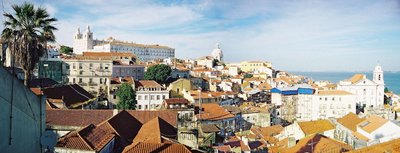
The heart of the city is the Baixa or lower town, this area of the city is being considered for UNESCO World Heritage Site status. The Baixa is organized in a grid-system and a network of squares built after the 1755 Lisbon earthquake. The São Jorge Castle and the Santa Maria Maior Cathedral are located on one of the seven hills of Lisbon, to the east of the Baixa. The oldest district of the city is Alfama, close to the Tagus, which has made it relatively unscathed through the various earthquakes.
Other monuments include:
Jerónimos Monastery, Belém Tower The Castle of São Jorge, atop the tallest hill of the central city, Praça do Comércio (Commerce Square), Rossio Square, Restauradores Square, Elevador de Santa Justa, an elevator (lift) in Gothic revival style, built around 1900 to connect the Baixa and Bairro Alto.
The city of Lisbon is rich in architecture; Romanesque, Gothic, Manueline, Baroque, Traditional Portuguese, Modern and Post-Modern constructions can be found all over the city. The city is also crossed by great boulevards and monuments along these main thoroughfares, particularly in the upper districts; notable among these are the Avenida da Liberdade, Avenida Fontes Pereira de Mello, Avenida Almirante Reis and Avenida da República.
Ccb.jpg
Lisbon_cristo_rei.jpg
Notable among the city's museums are:
The Museu Nacional de Arte Antiga (National Museum of Ancient Art); the Museu dos Azulejos (Museum of Portuguese-style Tile Mosaics); the Museu Calouste Gulbenkian (Calouste Gulbenkian Museum, containing varied collections of ancient and modern art); the Oceanário de Lisboa (Lisbon Aquarium, largest in Europe); the Museu do Design at Centro Cultural de Belém (Design Museum); the Museu Nacional dos Coches (National Coach Museum, containing one of the largest collections of royal coaches in the world) and the Museu da Farmácia (Pharmacy Museum).
The monument to Christ King (Cristo Rei) (http://www.m-almada.pt/website/main.php?id=91) stands on the left side of the river, in Almada. Open arms, overlooking the whole city, it resembles the Corcovado monument in Rio de Janeiro, and was built after the World War II, as thanksgiving for Portugal being spared the horrors and destruction of the war.
History
According to varying reports, the city was founded either by Phoenicians or Greeks. The Greeks knew it as Olissipo, derived from Ulysses; over time, this became Olissipona, Lissapona, then al-ʾIšbūnah (Arabic الأشبونة) under the Arabs, and finally the modern Portuguese Lisboa. The city was part of Roman Lusitania (although not the capital), was taken by Moors in the Eighth Century (approximately 711), was reconquered 1147 by Dom Afonso Henriques, first king of Portugal (with the help of crusader Gilbert of Hastings, who became the first Bishop of Lisbon; see Siege of Lisbon), and has been the capital of Portugal since 1255. The University of Lisbon was founded in 1290. Lisbon reached its peak of prosperity during the period of the Portuguese Empire in the 16th century. On 26 January 1531 the city was hit by an earthquake which killed thousands.
The XVI century marks the golden age for Lisbon. The city became the European hub of commerce with the Far East, while gold from Brazil also flooded into the city.
On 1 November 1755 Lisbon was destroyed by another earthquake, the 1755 Lisbon earthquake, which killed 90,000 and destroyed eighty-five percent of the city [1] (http://nisee.berkeley.edu/lisbon/index.html). Voltaire wrote a long poem, "Poeme sur le desastre de Lisbonne", shortly afterwards, and mentioned the earthquake in his 1759 novel Candide (indeed, many argue that this critique of optimism was inspired by that earthquake). Oliver Wendell Holmes, Sr. also mentions it in his 1857 poem, The Deacon's Masterpiece, or The Wonderful One-Hoss Shay.
After the 1755 earthquake, the city was rebuilt largely according to the plans of the Marquês de Pombal; hence the designation of the lower town as Baixa Pombalina.
Lisbon was the centre of a republican coup October 4-5,1910 and the Carnation Revolution of April 25, 1974, which overthrew Antonio Salazar's successor Marcelo Caetano, the last prime-minister of the Portuguese Corporative Regime: the Estado Novo.
Events
In 1994, Lisbon was the European Capital of Culture.
Expo '98 was held in Lisbon. The timing was intended to commemorate the 500th anniversary of Vasco da Gama's sea voyage to India.
The Lisbon Agenda was an EU agreement on measures to revamp the EU economy signed in Lisbon at an EU summit in 1999, with progress well below original aspirations.
Lisbon hosted the Euro 2004 competition.
Every March the city hosts the world-famous Lisbon Half Marathon. One of the most attended events of its kind in the world.
It regularly hosts countless other international events including various NATO, EU and other summits.
Economy
Lisbon, as the capital city of Portugal, has an economy concentrated on services. Most of the headquarters of multinationals operating in Portugal are concentrated on this city. Greater Lisbon is also heavily industrialized, especially the south bank of the Tagus river.
The Lisbon region is by far the wealthiest in Portugal; it constitutes 45% of the Portuguese GDP, and in per capita terms it is well above the rest of Portugal and above the EU average. The Lisbon region is likely to stop receiving development aid from the EU in the coming years.
Transportation
Though the Lisbon public transportation network is extremely far-reaching and reliable, the city still suffers from endemic severe traffic problems.
Lisbon's transportation system has the Metro as its main artery. Connecting the city centre with the upper and eastern districts. Ambitious expansion projects will increase the network by almost one third, connecting the airport, and the northern and western districts. Bus, funicular and tram services have been supplied by the Companhia de Carris de Ferro de Lisboa (Carris), for over a century.
There are four suburban lines departing from Lisbon: the Cascais, Sintra and Azambuja lines as well as a fourth line to Setúbal crossing the Tagus river over the 25 de Abril bridge.
April_25_Bridge,_Lisbon.jpg
The city is connected to the far side of the Tagus by two imponent bridges:
- The April 25 Bridge, inaugurated (as the Ponte Salazar) August 6, 1966, and later renamed after the date of the Carnation Revolution. It is the longest suspension bridge in Europe and a replica (made by the same engineers) of the Golden Gate bridge in San Francisco.
- The Vasco da Gama Bridge, inaugurated May 1998, is one of the longest in the world and the longest in Europe.
Lisbon is connected to its suburbs and the rest of Portugal by an extensive motorway network. There are three circular motorways around the city; the 2ª Circular, the CRIL and the CREL.
Colleges and Universities in Lisbon
There are 3 major state universities in Lisbon, the University of Lisbon, founded in 1911 (it is the oldest institution of higher education in Lisbon), the Technical University of Lisbon and the New University of Lisbon, all of them providing degrees in the sciences, engineering, education and humanities. There is also a polytechnic institute, the Polytechnical Institute of Lisbon (http://www.ipl.pt). Major private institutions of higher education include the renowned Catholic University (http://www.ucp.pt), as well as the Modern University of Lisbon (http://www.umoderna.pt/), the Lusíada University (http://www.ulusiada.pt/), the Lusófona University of Humanities and Technologies (http://www.ulusofona.pt/) and the Autonomous University of Lisbon (http://www.universidade-autonoma.pt/).
Miscellaneous
- Two EU agencies are headquartered in Lisbon; the European Monitoring Centre for Drugs and Drug Addiction (EMCDDA) and the European Maritime Safety Agency (EMSA). The CPLP (Community of Portuguese Language Countries [Portuguese Commonwealth]), is also headquartered in Lisbon.
- Lisbon is the original birthplace of fado music.
- The remains of Luís de Camões, author of the epic Os Lusíadas, can be visited at the Jerónimos Monastery. The remains of other great Portuguese men and women can be visited at the National Pantheon.
- Lisbon is served by Portela Airport, the largest in Portugal. Plans for construction of a new airport in Ota (50 km from Lisbon) have been around for years, with systematic postponements.
- The football clubs SL Benfica and Sporting Clube de Portugal, playing in the highest Portuguese division and the European competitions are from Lisbon.
Constructions
Prominent people born in Lisbon
- José Durão Barroso (born 1956), politician
- Catherine of Braganza (1638-1705), queen consort of King Charles II of England
- Richard William Church (1815-1890)
- Rita Guerra (born 1967), singer
- Pope John XXI, né Petrus Juliani (1215-1277)
- Anthony of Padua (1195-1231)
- Fernando Pessoa (1888-1935)
- Paula Rego (born 1935), painter, illustrator and printmaker
- Amália Rodrigues (1920-1999), fado singer
- Mário Soares (born 1924), politician
External links
- Lisbon Guide (http://www.lisbon-guide.info/) a detailed guide to Lisbon and meeting point for foreigners living in the city.
- Turismo de Lisboa (http://www.atl-turismolisboa.pt/sitemap_uk.htm) offers a comprehensive overview of the city for visitors, including a zoomable map.
- Webcam in Lisbon (Lisboa) (http://webcam.deili.info/en,1,24,143)
- Lisbon Photos (http://www.lisbonphotos.net/) a collection of Photos, showing Lisbon as it is to visitors.
- A few piectures of the City, available under Creative Commons Licence CC-BY (http://francois.schreuer.org/photos/20050202_lisbonne.html)bg:Лисабон
ca:Lisboa da:Lissabon de:Lissabon es:Lisboa eo:Lisbono fr:Lisbonne gl:Lisboa he:ליסבון hi:लिस्बन hu:Lisszabon id:Lisboa io:Lisboa is:Lissabon it:Lisbona la:Lisbonum ja:リスボン ko:리스본 nl:Lissabon no:Lisboa pl:Lizbona pt:Lisboa ro:Lisabona ru:Лиссабон simple:Lisbon sl:Lizbona fi:Lissabon sv:Lissabon zh:里斯本

